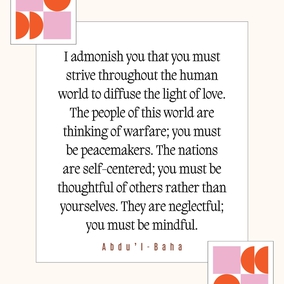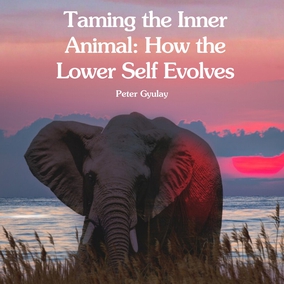The views expressed in our content reflect individual perspectives and do not represent the authoritative views of the Baha'i Faith.
The Book of Revelation foretold “Christ’s new name,” which presented an unsolved mystery for Christians and Biblical scholars to ponder for the past two thousand years.
The Bible does not just mention the idea that Christ will appear in a “new name” in passing. The Book of Revelation strongly emphasizes it four separate times:
He that hath an ear, let him hear what the Spirit saith unto the churches; To him that overcometh will I give to eat of the hidden manna, and will give him a white stone, and in the stone a new name written, which no man knoweth saving he that receiveth it. – Revelation 2:17
Him that overcometh will I make a pillar in the temple of my God, and he shall go no more out: and I will write upon him the name of my God, and the name of the city of my God, which is new Jerusalem, which cometh down out of heaven from my God: and I will write upon him my new name. – Revelation 3:12.
His eyes were as a flame of fire, and on his head were many crowns; and he had a name written, that no man knew, but he himself. – Revelation 19:12.
And there shall be no more curse: but the throne of God and of the Lamb shall be in it; and his servants shall serve him: And they shall see his face; and his [new] name shall be in their foreheads. – Revelation 22:3–4.
By dint of this focus on Christ’s “new name,” the concept is obviously important, whatever it means.
The Baha’i teachings forge a new connection regarding this mystery: they say that Christ’s “new name” may well be associated with the “New Jerusalem,” which is also foretold in the Book of Revelation. Another connection may also be made between Christ’s “new name,” the “New Jerusalem,” and the “new heaven and a new earth”:
… I will write upon him the name of my God and the name of the city of my God, the New Jerusalem that descends out of heaven from my God, and my own new name. – Revelation 3:12.
And I saw a new heaven and a new earth: for the first heaven and the first earth were passed away; and there was no more sea. – Revelation 21:1.
We are told in the Holy Scripture that the New Jerusalem shall appear on earth. Now it is evident that this celestial city is not built of material stones and mortar, but that it is a city not made with hands, eternal in the Heavens.
This is a prophetic symbol, meaning the coming again of the Divine Teaching to enlighten the hearts of men. It is long since this Holy Guidance has governed the lives of humanity. But now, at last, the Holy City of the New Jerusalem has come again to the world, it has appeared anew under an Eastern sky; from the horizon of Persia has its effulgence arisen to be a light to lighten the whole world. – Abdu’l-Baha, Paris Talks, p. 84.
So let’s see if we can connect these dots! In the process of doing so, we’ll use a three-step methodology for figuring out this prophecy:
1. how the original audience may have understood the original author’s intent; followed by
2. a sense of how the same prophetic text has been interpreted in subsequent centuries; and, finally
3. how the very same text may be understood and applied to the present-day context, especially in regard to the Baha’i teachings.
So what do the Baha’i teachings have to offer in terms of understanding and interpreting these prophecies? Rather than citing well-known instances of Baha’i interpretations of prophecy, it may be more useful to invoke the important Baha’i principle of the harmony of science and religion.
The study of religion, strictly speaking, is not a science in the widely understood use of the term, but an important German term for the academic study of religion is Religionswissenschaft, or “science of religion.” So, by using this proposed methodology – a new, three-pronged analytical paradigm – what can we say about the history of the interpretation of these remarkable passages from the Book of Revelation regarding the New Jerusalem? Let’s look at these short examples:
One New Testament scholar underscored the importance of the vision of the New Jerusalem this way:
Just as the Gospels were composed with a view to the Passion and Resurrection and progress carefully toward that goal, so also the Revelation of John was constructed with the heavenly Jerusalem in mind and unfolds inexorably toward this culmination. The vision of the city of God [the New Jerusalem] is the longest and most elaborate vision of the book. Every item was anticipated by the author, no detail is superfluous, each image is laden with meaning. – William W. Reader, “The Twelve Jewels of Revelation 21:19-20: Tradition History and Modern Interpretations,” Journal of Biblical Literature, September, 1981, p. 433.
In another insightful example of New Testament scholarship on this issue, Robert H. Gundry, after careful textual analysis, concluded:
Symbolic language fills the Book of Revelation as it fills other apocalyptic literature. We may therefore presume that the description of the New Jerusalem in Rev 21:1–22:5 deals in symbolism. Our presumption is rewarded when we read of the city’s coming down out of heaven, stretching out and up to unheard-of dimensions, having gates that each consist of a single pearl, with gold that can be seen through, and so on. Such language invites symbolic interpretation, whatever the nature, concrete or abstract, of the reality so described. But the New Jerusalem is a very large symbol. …
And just as the city is God’s tabernacle, he and the Lamb are the temple of the city (21:22). Ordinarily, God dwells in the temple and the temple is located in the city. Here, he and the Lamb are the temple, so that the city, since it is the cubically shaped Holy of holies, is located in the temple – a striking reversal which means that the saints will dwell in God and the Lamb just as God and the Lamb will dwell in them. – Robert H. Gundry, “The New Jerusalem: People as Place, Not Place for People,” Novum Testamentum, July, 1987, pp. 254, 256.
Professor Gundry connects Revelation 3:12 – the “new name” verse – with Revelation 21:22 – the “New Jerusalem.” This significant insight shows that the Temple – and the New Jerusalem itself – is transformed from a place to a person or persons. In other words, the physical buildings are metaphysically and metaphorically transfigured into spiritual realities, just as the Baha’i teachings suggest:
… the religion of God is described as the Holy City or the New Jerusalem. Clearly, the New Jerusalem which descends from heaven is not a city of stone and lime, of brick and mortar, but is rather the religion of God which descends from heaven and is described as new. – Abdu’l-Baha, Some Answered Questions, newly revised edition, p. 77.
In a word, the world is made “new” in the Last Day – the first day of a cycle of fulfillment, the dawning of the new creation.
















Comments
Sign in or create an account
Continue with Googleor